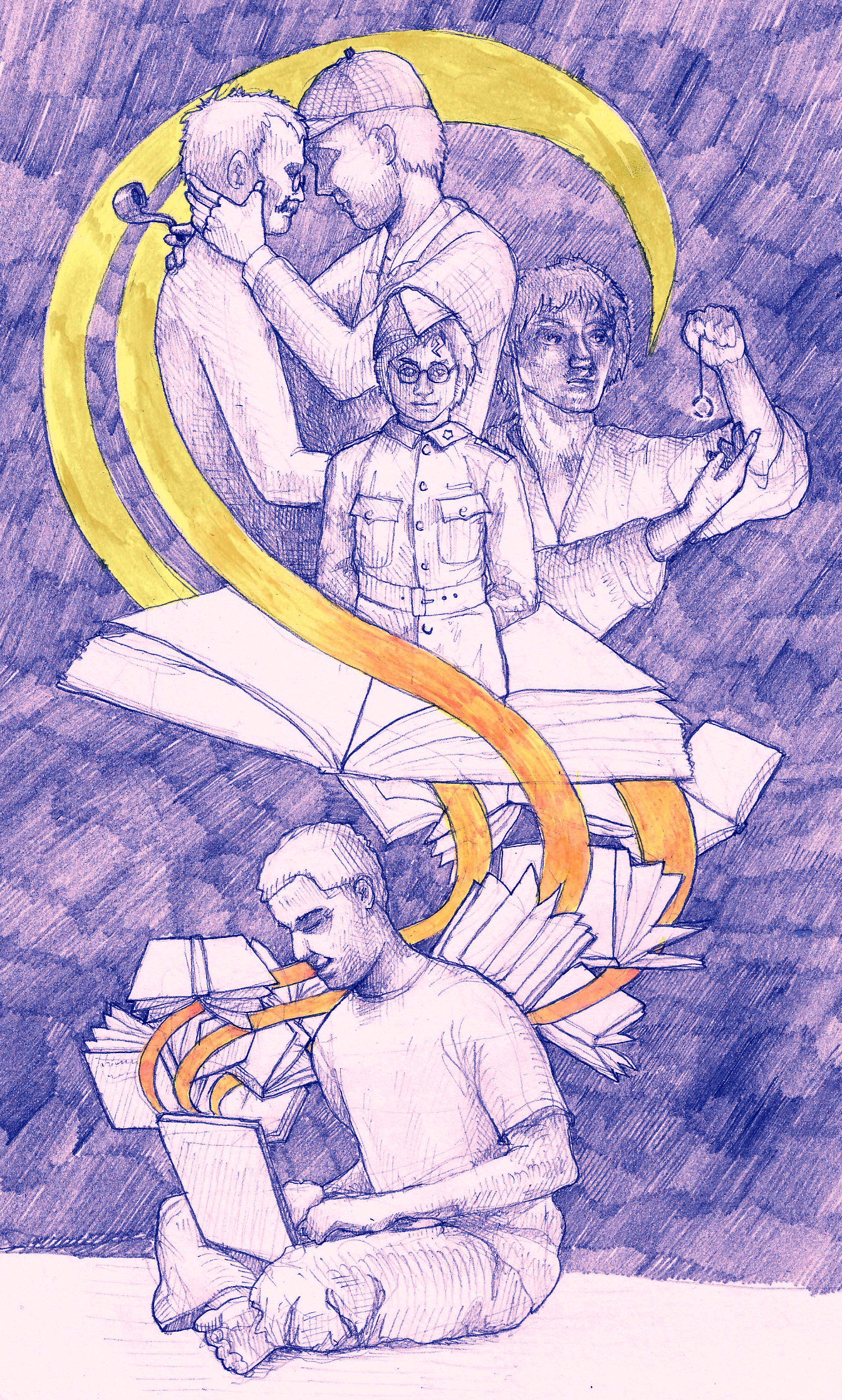Full Frontal Fandom
By Daniel Taroy; Illustrations by Jane McCurn
After wolfing down breakfast and squeezing into a van on a Saturday morning, Gael Sweeney and four friends stand in front of the closed storefront of a Barnes & Noble in Georgetown, Washington, D.C. The clock reads 8 a.m., too early for waiting under a grey sky in a line yet to form.
Sweeney, an SU writing professor and fanfiction author, huddles closer to the rest of the group—people she’d met online but never in person—for warmth. While fan groups for Harry Potter or Star Wars demand a dress code for their events, Sweeney’s leather jacket and red scarf relates less to dressing up for the day’s Queer As Folk DVD signing and more to the March weather.
An hour later, the store’s manager approaches Sweeney’s group, baffled. “Why are you here so early?” he asks.
Sue, her editor, answers with a question. “How many people are you expecting to be here?”
“I don’t know. Maybe about 100.”
Later that day, more than 700 Queer As Folk fans will line the streets for autographs and pictures with their favorite cast members, and the bookstore will send out for extra DVD box sets to keep up with the endless demand. But at 9 a.m., none of the signs indicate a future mob scene. “You have no idea what this is going to be like,” Sue says. “You have no clue, do you?”
The manager glances out at the empty stretch of pavement behind them. “You’re starting to scare me.”
Sue laughs. “You should be scared.”
Fanfiction, the invisible underbelly of published work, allows fans to anonymously alter famous storylines with no desire, or real intention, to officially “publish” their stories. These authors opt for online glory instead. Since kicking off in the 1880s, fans have messed with Sherlock Holmes’s murder suspects and his rippling sexual attraction to sidekick Watson. But female Trekkies dreaming up sexual fantasies aboard the USS Enterprise finally pushed fanfiction into the mainstream. Today, thanks to a labyrinth of online blogs and fan sites, fanfiction creates globally diverse fan communities. FanFiction.net, the world’s largest fanfiction archive, boasts 6,600,000 registered titles—authored by 781,000 of its 2,400,000 members—accessed by readers from 173 different countries. FanFiction.net rivals Facebook in the amount of time spent browsing online, but unlike other popular social networking sites, fanatics don’t know the people with whom they trade storylines and build virtual relationships.
 Sweeney wrote her first Queer As Folk fanfiction in 2001, a year after the first episode aired on Showtime and two years before 700 fans swarmed Georgetown’s streets. Over 8,800 unique visitors dropped by her LiveJournal account in the last two years, and her Yahoo! Group lists 1,150 readers.
Sweeney wrote her first Queer As Folk fanfiction in 2001, a year after the first episode aired on Showtime and two years before 700 fans swarmed Georgetown’s streets. Over 8,800 unique visitors dropped by her LiveJournal account in the last two years, and her Yahoo! Group lists 1,150 readers.
Some mornings, she scrolls through a map of that day’s LiveJournal visits, blue dots representing readers from around the world. While most come from the U.S., half come from Europe and a handful from the wintry heart of Russia. One reader hailing from Australia even sent her a birthday present—a quilt woven to include every Queer As Folk cast member. That gift, she explains, exemplified the true level of devotion present in fanfiction communities. “You don’t know about your readers’ lives unless you’ve actually met them,” she says. “And I feel like I have.”
Kristina Busse, a member of the Organization of Transformative Works (OTW)—a nonprofit organization dedicated to preservation of fanworks—and a founding editor of its journal Transformative Works and Cultures, sees the power of fanaticism firsthand. “If you’re interested in a certain thing and can’t find a group where you live, you can turn to the Internet,” she says. Archive of Our Own, an OTW-sponsored hosting site for fanfiction and other fanworks, includes nearly 150,000 users involved in nearly 12,000 fandoms, encompassing everything from historical Twilight re-imaginings to smutty Hunger Games role-play scenes. The Archive, however, only represents a small chunk of the other communities and works sprawled across platforms like Tumblr, LiveJournal, and hundreds more.
The Internet is fandom’s lifeblood. Abigail Reynolds realized that through experience writing Jane Austen fanfiction on sites like The Republic of Pemberley and the Derbyshire Writers’ Guild. Six years of writing canon stories—or plotlines following Austen’s official novels—turned sour shortly after she received a publishing offer in 2007. “People I had thought of as friends turned around and attacked me,” Reynolds says. “I thought they would be delighted, which was kind of naïve.”
But shafting fan friends is the cruel exception to an otherwise supportive online home. For Tumblr user Kat, her fan friends were lifesavers. She dipped her toes into the fandom pool at age 11 after prowling online message boards and Yahoo! Groups for fanfic on Degrassi: The Next Generation, the Canadian teen soap that made the American jump to TeenNick. Thirteen years later, in 2012, her fan friends kept her afloat when she lost both her parents. Messages flooded into her account for months. “Near perfect strangers helped me get through the situation better than anyone in my real life was able to,” she says.
Since then, real life continues to infiltrate her fanfic sphere. Recently, a reader submitted a private message claiming Kat’s fiction saved her life. “Instead of wanting to self-harm to release her stress, she’d read my fic,” Kat says.
Thanks in part to the Internet’s accessible and endless fanfic library, more and more of the fanfiction community has shed its invisibility cloak. On Archive of Our Own, Kat’s newest fandom, U.K. boy band One Direction accounts for over 7,000 posts. On LiveJournal, nearly 4,000 users subscribe to the One Direction Fanwork community. A quick Tumblr search yields countless posts of the boys in varying photo and video clip manipulations along with fanfic.
Though nowhere near as comprehensive as Harry Styles and co., Jane Austen fanfiction remains an online social activity, according to Reynolds. Her novels accompany constant virtual outreach to the fandom through online social media—a recent Facebook post asking overseas readers for Britishisms yielded 27 suggestions. While Reynolds’ publication offer—the first in her group of friends—splintered her Austen fan community with jealousy, it reinforced bonds in her immediate circle. She and Sharon Lathan founded Austen Authors, a blog with 20 other published novelists, to promote the Austen genre and support its subscribers. When a group blogger developed an iPhone app to aggregate fanfic-related news, community members helped finance the project through a Kickstarter campaign. When Hurricane Sandy hit, authors donated book profits to the Red Cross.
Steve Cohan, an SU English professor specializing in popular culture and cultural studies, compares fandom to the power of likeminded sport diehards. Reynolds knows her well-to-do Jane Austen fanfiction can’t compete with Orcs sleeping with Ents in Lord of the Rings offshoots, or a Gryffindor Tower gangbang in Harry Potter fic. But she also realizes fandoms are distinct—Jane Austen represents a more conservative branch. “The fans are all trying to act and talk like Jane Austen, so we don’t bring out our swords or anything,” she jokes. Having met fellow Austenians at conventions over the years, she knows the community well. In 2011, she ventured overseas to meet with a fellow novelist and long-time online friend living in the U.K. Together they ambled down the city of Bath’s cobblestoned backstreets where Austen once walked herself. She toured the ruins of Fountains Abbey with a Swiss author, spending hours bouncing around plotlines. “It changes the whole writing experience from sitting alone in an attic,” she says. “It’s a group where we can do almost anything.”
Rivalries exist, although they revolve around opposing views on characters and relationships—like pairing, or “shipping,” Harry with Hermione rather than book-approved Ginny. Some even ship Harry with Ron or fan-favorite Draco in the graphically sexual “slash fic” genre. Within the One Direction fandom, most fanfics ship the boys with each other; nearly half on Archive of Our Own ship Harry Styles with bandmate Louis Tomlinson—raising writers’ hackles who'd rather ship the boys with themselves.
Beyond the minutiae, however, exists the stronger loyalty to source material and its fans. “Fanfiction is not only a creative outlet, but a form of escapism and fantasy,” Kat says. “It’s about the people.”
Yet, some writers get so caught up that they become part of the fanfiction themselves. In the Queer As Folk fandom, Sweeney remembers Carol, a woman in her sixties posing as a gay man named Randall, who lived in Dallas with a partner and child. “She would talk about how her partner was a policeman injured in some way, and people would send get-well presents,” Sweeney says. Carol’s lies and popularity lasted more than a decade—until she died.
Then, the truth came out. “It was just fanfiction, layers of fanfiction,” Sweeney says. Betrayed fans raged against other fans, banishing the ones privy to the deception and excluding them from their online groups. But experiences like these, Sweeney says, provide a testament to the community’s investment in fandom and the people involved in it—from the run-of-the-mill readers to the oddballs and everyone else in between. Controversy just comes with the territory. “This is the way it works,” she says. “And it goes like this in all fandoms.”


